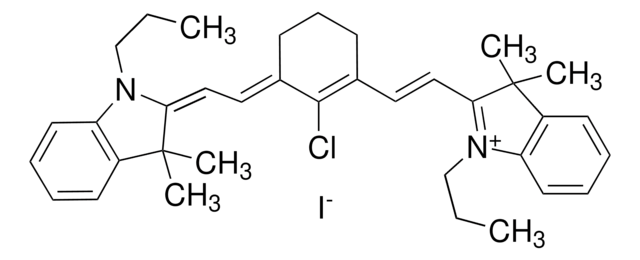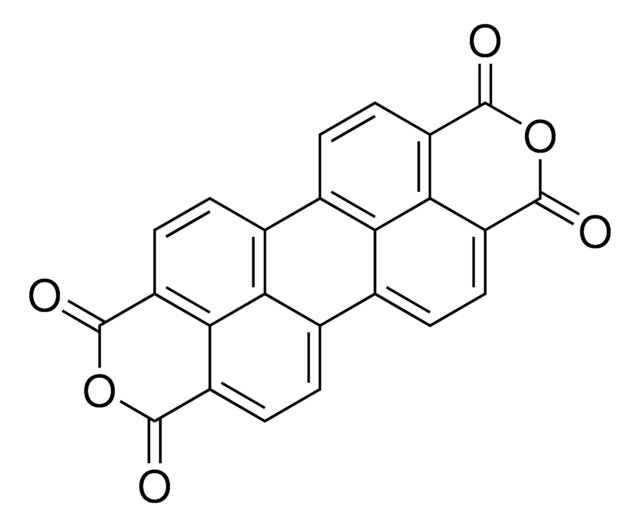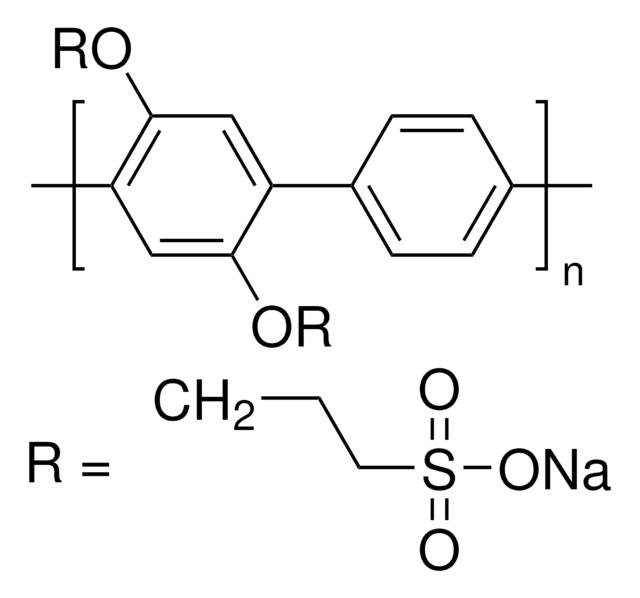546461
MDMO-PPV
light-emitting polymer
Synonyme(s) :
MDMO-PPV
About This Item
Produits recommandés
Description
Band gap: 2.2 eV
Poids mol.
Mn ~120,000
Solubilité
toluene, xylene, THF, chloroform, chlorobenzene, cyclohexanone: soluble
Fluorescence
λex 485 nm; λem 555 nm in toluene
Énergie orbitale
HOMO -5.4 eV
LUMO -3.2 eV
Performance des dispositifs OPV
ITO/PEDOT:PSS/MDMO-PPV/PC61BM/Al
ITO/PEDOT:PSS/MDMO-PPV:PC61BM (1:4)/LiF/Al
Chaîne SMILES
COc1ccc(OCCC(C)CCCC(C)C)cc1C=C
Description générale
Application
Code de la classe de stockage
11 - Combustible Solids
Classe de danger pour l'eau (WGK)
WGK 3
Point d'éclair (°F)
Not applicable
Point d'éclair (°C)
Not applicable
Équipement de protection individuelle
Eyeshields, Gloves, type N95 (US)
Faites votre choix parmi les versions les plus récentes :
Déjà en possession de ce produit ?
Retrouvez la documentation relative aux produits que vous avez récemment achetés dans la Bibliothèque de documents.
Les clients ont également consulté
Articles
New conducting and semiconducting polymers for plastic electronics
The union of distinct scientific disciplines is revealing the leading edge of Nanotechnology.
The development of high-performance conjugated organic molecules and polymers has received widespread attention in industrial and academic research.
Light-Emitting Polymers
Notre équipe de scientifiques dispose d'une expérience dans tous les secteurs de la recherche, notamment en sciences de la vie, science des matériaux, synthèse chimique, chromatographie, analyse et dans de nombreux autres domaines..
Contacter notre Service technique![Poly[2-methoxy-5-(2-ethylhexyloxy)-1,4-phenylenevinylene] average Mn 40,000-70,000](/deepweb/assets/sigmaaldrich/product/structures/344/488/b8f8179d-3970-4deb-a754-adda88cdb36f/640/b8f8179d-3970-4deb-a754-adda88cdb36f.png)

![Poly[(9,9-di-n-octylfluorenyl-2,7-diyl)-alt-(benzo[2,1,3]thiadiazol-4,8-diyl)] average Mn ≤25000](/deepweb/assets/sigmaaldrich/product/structures/428/661/1c4ebb98-9d51-48c0-96c7-e556ca425aa4/640/1c4ebb98-9d51-48c0-96c7-e556ca425aa4.png)
![Poly[5-methoxy-2-(3-sulfopropoxy)-1,4-phenylenevinylene] potassium salt solution 0.25 wt. % in H2O](/deepweb/assets/sigmaaldrich/product/structures/111/584/9e24dfe5-3cb6-4bd8-8bc6-cbe82c1b88cd/640/9e24dfe5-3cb6-4bd8-8bc6-cbe82c1b88cd.png)

![Poly[(m-phenylenevinylene)-co-(2,5-dioctoxy-p-phenylenevinylene)] light-emitting polymer, predominantly trans](/deepweb/assets/sigmaaldrich/product/structures/249/040/9442b889-4fa0-4b4a-b424-cff0769a5ef2/640/9442b889-4fa0-4b4a-b424-cff0769a5ef2.png)



